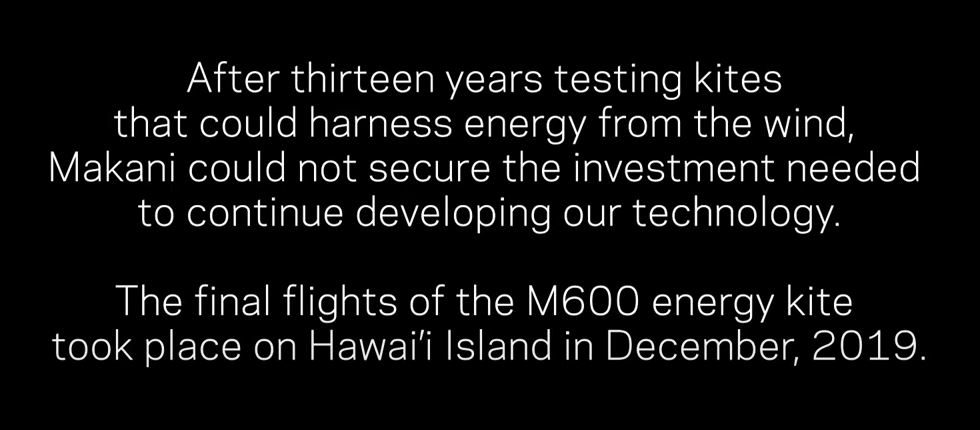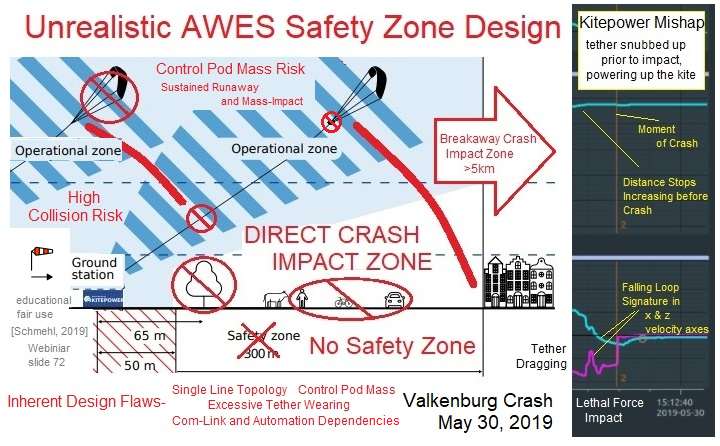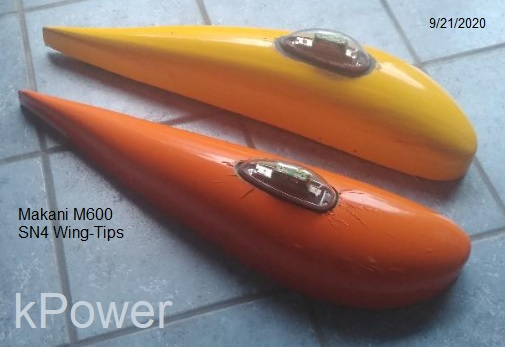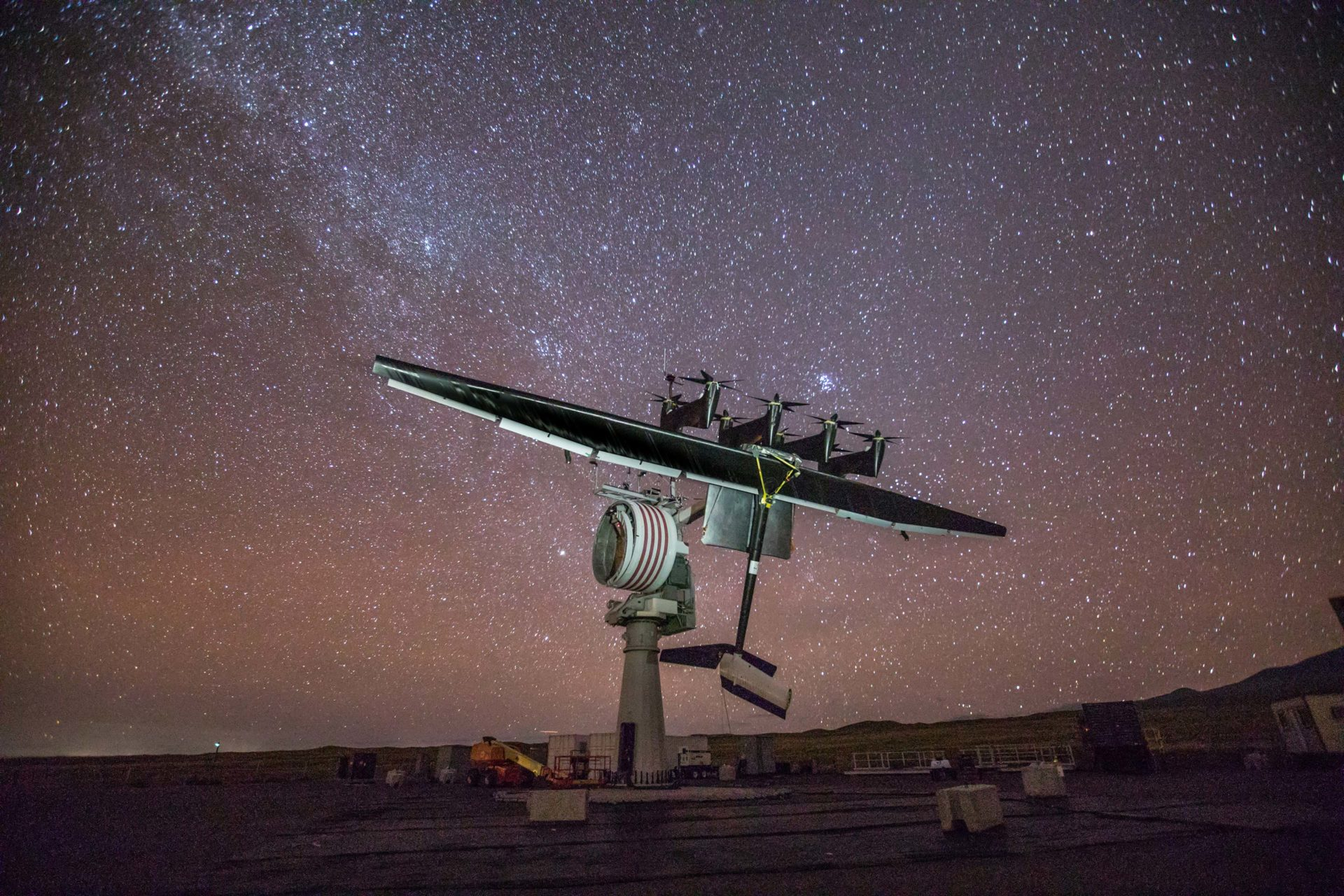New Yorker "Inherit the Wind" article holds some historical gems.
>> See furthering: MX2
==============================
15 Sep 2020 | 21:00 GMT
Exclusive: Airborne Wind Energy Company Closes Shop, Opens Patents
Former chief engineer of Makani speaks to Spectrum about energy kites and the future of AWE
By Mark Anderson
==============================
- Makani - Energy Kite Technical Videos 84 videos
- Trailer: XbWbb
- Energy Kite 1,187 pages: Published September 2020
- Part I 417 pages PDF
- Part II, Technical Artifacts 369 pages PDF
- Part III, Technical Artifacts 401 pages PDF
- A long and windy road
Fort Felker
Feb. 18, 2020
"so from today Makani’s time at Alphabet is coming to an end"
"Shell is exploring options to continue developing Makani’s technology."
- NEWS from their site
- Video channel
- https://en.wikipedia.org/wiki/Captive_helicopter
- M600 and their technology of energy kite drone, rigid wing, single compound tether, flygen
- Makani Offshore Giant Energy-Producing Kite Launched From a Floating Platform By Sia Magazin - June 1, 2020 [Authro apparently had not realized that the company exited from operations.]
- Makani's first offshore energy kite flight
94,435 views•Aug 15, 2019 - A Crazy Idea: Makani's Self-Flying Energy Kite
5,866 views • Jul 8, 2019
- Makani
crashes at Sea
- Open
Letter to AWEurope and Google/Makani at AWEC2019
- http://www.energykitesystems.net/FAA/FAAfromMakani.pdf
- http://www.energykitesystems.net/0/makanipower/index.html
- Feb 12, 2019 Makani takes to the ocean with Shell
Makani is now an independent company and is partnering with Shell to bring energy kites to offshore environments
Fort Felker
Feb 12, 2019 [Year later: Makani is dropped by Alphabet]
- US8800931B2 Planform configuration for stability of a powered kite and a system and method for use of same
- [ ] So, Shell, what are you going to do in AWE? Will
you explore other AWE
methods?
Ed
- ?? [ ] : "The drone became damaged and unusable as it missed its mark due to a ‘‘subtle and unexpected aerodynamic effect” a Makani spokesperson said, and plunged into the water." Source? Details?
- A year ago: Shell joins Alphabet in power-generating kites plan
Note: Antonello Cherubini. "Mr Cherubini said it was still unclear whether Makani could escape the fate of the other airborne wind energy start-ups that had already failed." Feb. 2019.
- person-who-controls-camera-creates-history-makani-technologies
- BuzzFeedzz features an early Makani interview with Fort Felker.
-
and
- RPX Remote Perch Crosswind
M600—Remote Perch Crosswind Flight 02 (RPX-02), December 14, 2016 - SN3 ???? [ ] ? Anyone?
- https://x.company/projects/makani
- Whack!
- 2020 special PDF
- Flight Logs | Data Sets
- Makani Power, LLC., in exit fine gesture extends their lessons and data through a substantial sharing into the AWEC2020 Teleconference. IP placed into OpenAWE pool. Here001 | Here002 | And Here003e MX2 system fuzzily pokes the future.
- tether drag ratio
- power coefficient for tether drag
- virtual hub height
- tether roll angle
- loop angle
- optimum kite speed strategy
- AWTs
- induced flow
- Flutter study R.S, and J. W.
- Debatable: "Makani’s researchers found out
early on that rigid kites could more efficiently harness energy from the wind." When all costs are faced, their finding may not hold true; discuss such question in dedicated topics; perhaps the flip might hold.
- Makani Technologies LLC
- 28042 Makani crashes at Sea Note posted on Aug. 15, 2019, by Dave Santos
- https://makanifilm.com/ Andrea Dunlap
Pulling Power from the Sky: The Story of Makani [Feature Film] Clip:

MAKANI ENERGY LOST ITS GREEN
Thursday, October 29, 2020
Richard Bangert
“The accident underscored a feature of Makani’s technology that has led experts to question why [Makani founders] Brin and Page had so much faith in the concept,” stated Deign. “Out of all the possible ways to make an airborne wind engine, Makani’s was perhaps among the most complicated.”
Click image for larger-clearer viewing:

Makani M600 Wing-Tips Collected by kPower for Public Exhibition
kPower Austin has acquired from its Hawai'ian Agent the wing-tips of what is reckoned to be Makani M600 SN4. These are intended to end up on permanent display at American Wind Power Museum and World Kite Museum, as part of their growing AWE collections. kPower has been donating historic AWE artifacts to these museums for over a decade.
IMAGEofWingTips

Analyzing Makani's Epic R&D Case
Sweet "Dreaming" of an Energy Kite
What brave happy little souls-
"...the [M600] hardware would be put through the paces of simulated hover flight. This "motor HITL" was done in a test bay with the kite securely strapped to a large trailer...More than one engineer compared the test to the kite "dreaming." " (Makani Final Report)
All four M600s ever flown crashed.
Collecting Historic Airborne Wind Energy Platform ("Power Tower" and "Energy Airplane")
 Click image to enlarge.
Click image to enlarge.============================
Mr. Santos
July 2020: Roland Schmehl posted at AWES.
We have just now released two important technical reports about Makani’s Wing7 and M600 to the public:
Jelle Wijnja: Aero-Elastic Analysis of a Large Airborne Wind Turbine. M.Sc. Thesis, Delft University of Technology, 27 Nov 2013.
http://resolver.tudelft.nl/uuid:0d778339-a97e-423a-b3a8-64ab7a64417f 4
Thomas
van Alsenoy: Sensitivity Analysis of Airborne Wind Turbine Design
Variables – Using Trajectory Optimization. M.Sc. Thesis, Delft
University of Technology, 22 May 2014.
http://resolver.tudelft.nl/uuid:5a4b8f8d-6cea-4e75-ba11-8da3fe4457cc 5
Jelle and Thomas were two MSc students of TU Delft’s Faculty of Aerospace Engineering performing their graduation project with Makani in California. The two MSc theses detail the development status of the two prototypes, the smaller Wing7, with 4 onboard wind turbines, and the larger M600, with 8 onboard wind turbines, totaling 600 kW of electrical power.
Jelle’s research was about the aeroelastic behavior of the M600, including a detailed description of structural, aerodynamic and control properties of this largest AWE prototype to date. Several aeroelastic modes are investigated, including flutter, distinguishing different flight regimes. The theoretical analysis was performed with a modified version of the popular simulation code ASWING and complemented by wind tunnel measurements at TU Delft. The research formed the basis for the paper Aeroelastic Analysis of a Large Airborne Wind Turbine 1 that appeared in the Journal of Guidance, Control, and Dynamics.
Thomas’ research was about the system design of Wing7. The research covers all system components, also the rotors used for hovering and energy harvesting. This prototype has also been described in Damon Vander Lind’s book chapter Analysis and Flight Test Validation of High Performance Airborne Wind Turbines
Makani had intended to develop a 5MW version of its architecture (M5), hoping for a competitive unit-plant compared to HAWTs. Tallak can be certain that engineering scaling laws greatly prevented the M5 from development. Makani announced missed milestone after milestone during its 13yr run, due to well-understood aerospace challenges scaling up and automating aircraft.
Public measured comparison of Wing7 and M600 power curves would surely reveal severe square-cube scaling losses in efficiency, and that Makani likely will only share those power curves with Shell, who itself is under Google NDA, no doubt. The most experienced observers do know what happened. ~300M was plenty to prove informed doubts correct.
It seems very unlikely Shell let all Makani workers go, while intending to continue M600 development. It is time to spend money across all AWES architectures for systematic fly-off. Let the surviving M600 fleet be a part of that.
=====================
Ed adds: The Shell Game ?
Google AWE Big Fail; who knew? "Right Stuff" aviation community, in 2009, on early AWES Forum.
From: christopher carlin
Subject: Re: Makani's high-risk approach disclosed
To: santos
Date: Monday, March 9, 2009, 11:07 AMOff hand I must agree. Why carry the generator and wiring up in the air when you don't need to. Minimizing weight and equipment aloft has to be a primary objective.Regards,Chris-----------------On Mar 9, 2009, at 4:07 AM, dave santos wrote:
Google closes Makani
Teller said, some will "stay on for a few months to package up what they've learned so others can build on it."
Some headlines about the closure:
Google parent company Alphabet ends support for Makani kite-power project
Alphabet acquired Makani in 2013.
Alphabet takes the wind out of its Makani energy kites
Makani and its energy kites are parting ways with Alphabet
Google parent drops kite-power pioneer Makani
Shell mulls Makani energy-kite future as Google drops 'moonshot' project
Alphabet Shutters Its Energy Kite Company, Makani
Google parent company Alphabet ends support for Makani kite-power project
Energy & Science
Google Shuts Down Its Moonshot Wind Energy Unit Makani
"Alphabet Inc. is shutting down Makani"
Google's parent company is shutting down power-generating kite subsidiary Makani: 'The road to commercialization is longer and riskier than hoped'
Alphabet pulls support for Makani wind kites, Shell might continue development
Alphabet winds down energy kite division
Makani’s tech could be taken on by Shell
`Financial Times: Alphabet shuts power kites moonshot project
Alphabet shuts down its power-generating kites project
Los Angeles Times
Makani's time as an “other bet” comes to an end | Hacker News
Alphabet cuts cord on power-generating kite business
Google parent withdraws support for kite power outfit
Re-News
Alphabet abandons Makani’s energy-making kites project
Inceptive Minds
Future of Airborne Wind Energy in Doubt as Google Parent Drops Makani
Green Tech Media
Airborne Wind Energy in Doubt as Google Parent Drops Makani
FocusTechnica
RIP Google Makani: Perhaps The Entire Airborne Wind Energy Space Will Finally Disappear Michael Barnard
Alphabet, Google’s Parent Company, Axes its First “Moonshot” Company
- Also, a general-video link: MakaniPowerGENERALvideoMANY
Some Videos:
==============
Corwin Hardham at Benson High School
==========================
Saul Griffith: High-altitude wind energy from kites!
=====================
Quick takes: Makani power
=====================
A Different Kind of Wind Power: Damon Vander Lind at TEDxEmbryRiddle
=========================
Makani: Innovating for climate solutions
=========================
Makani Crosswind Flight
======================
The Makani Airborne Wind Turbine
======================
Makani's first offshore energy kite flight - YouTube
======================
Makani Energy Kite
======================
Makani Energy Kite: A Smarter Wind Turbine
======================
Google X acquires Makani Power for kite-like airborne wind turbines
======================
4 hr 45 min
Makani energy kite test flight, spring 2019 (full flight)
=======================
Makani energy kite flight summary
=======================
All Flight Modes of the Makani AWT
=======================
1 hr 32 min
Makani energy kite first night flight 2019 (full flight)
=================
Makani’s first commercial-scale energy kite
=================
Makani Power, Autonomous Power Generation, July 8, 2011
=================
Career Spotlight: Kite Designer
==================
Airborne Wind Turbine Flight Demonstrations
==================
Makani's Flying Wind Turbines - Solid Conference 2015
==================
Google develops floating data centers propelled by windmill-like kites
==================
Google X acquires Makani Power for kite-like airborne wind turbines
===================
A Crazy Idea: Makani's Self-Flying Energy Kite
===================
NCES 5.0: Corwin Hardham of Makani Power
===================
The Energy Fixers: Windmills in the Sky
===================
This video shows the loss of M600 design kite serial number 5 (SN5) in hover after the offshore flight FCW-01. This event highlighted the vulnerability of the M600 design to marginal roll stability in hover.
In FCW-01, the autonomous flight controller lost control of the kite’s roll attitude, then the kite’s yaw attitude, and, consequently, lost the kite to the Atlantic Ocean. The kite had just transitioned from crosswind flight to hover mode. It was preparing for the tether reel-in operation. In this “PrepTransformGsDown” flight mode, the kite hovers to a position to hold the tether in place so the Ground Station can transform from “the anchoring the tether for crosswind” configuration to the “reeling” configuration. To reach this position, the kite lowers its altitude while simultaneously translating sideways. After 22 seconds, the kite begins to overcome the bridle moment and roll away from the tether. About 28 seconds into PrepTransformGsDown mode, the pilot took over control but could not successfully stabilize the kite.
To learn more about the root cause of this crash please see "Root Cause Analysis and Corrective Actions for FCW-01," included in The Energy Kite: Selected Results From the Design, Development and Testing of Makani’s Airborne Wind Turbines, Part III, and available at https://x.company/projects/makani
August 8th, 2019. Filmed by Viktor Andreas Olsen in Karm°y, Norway.
This video is licensed under a Creative Commons Attribution-NonCommercial-NoDerivatives 4.0 International License.
License
Creative Commons Attribution license (reuse allowed)
Bleeps: "Ah F_____" "Stop everything" Era change moment. Shell, what next?
- First fabric kites
- First rigid-wing kites
- “Wing 7” 20kW prototype
- M600 600kW prototype
- Proposed: MX2